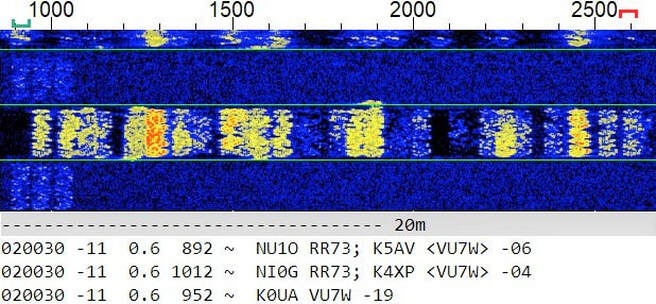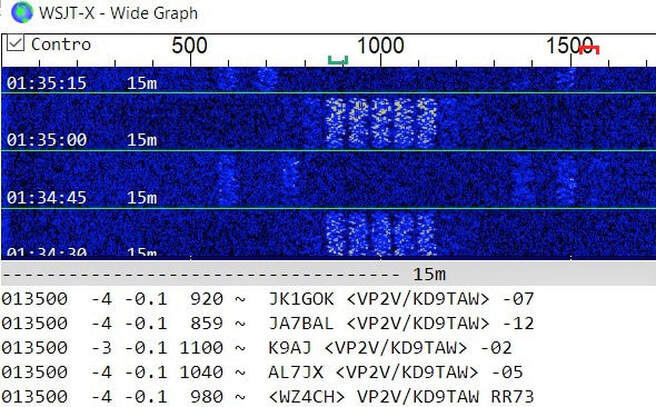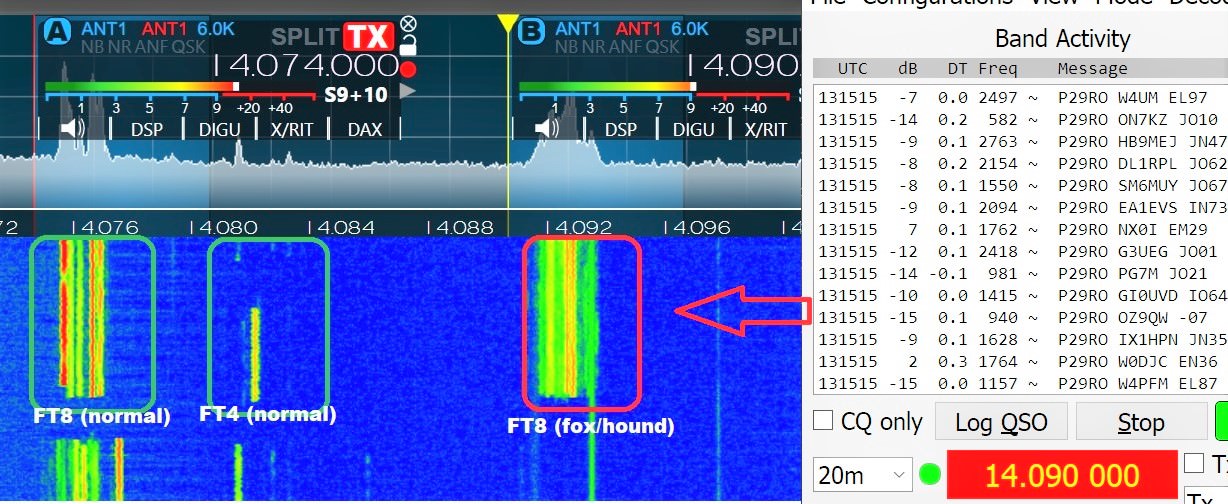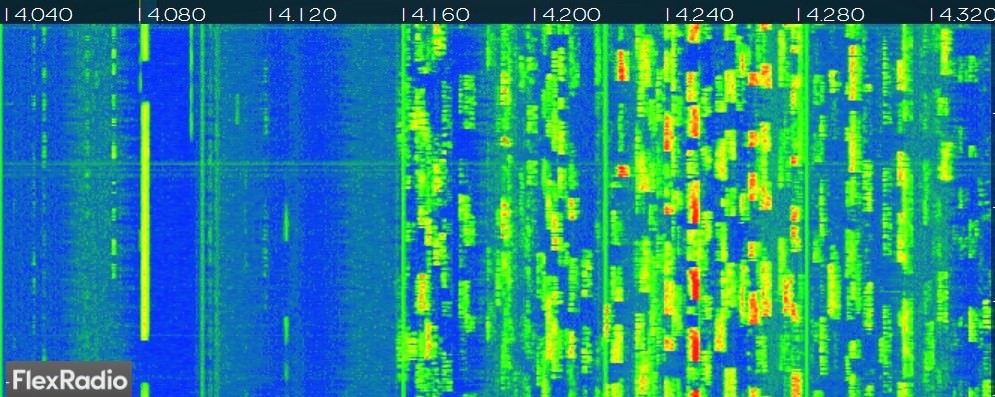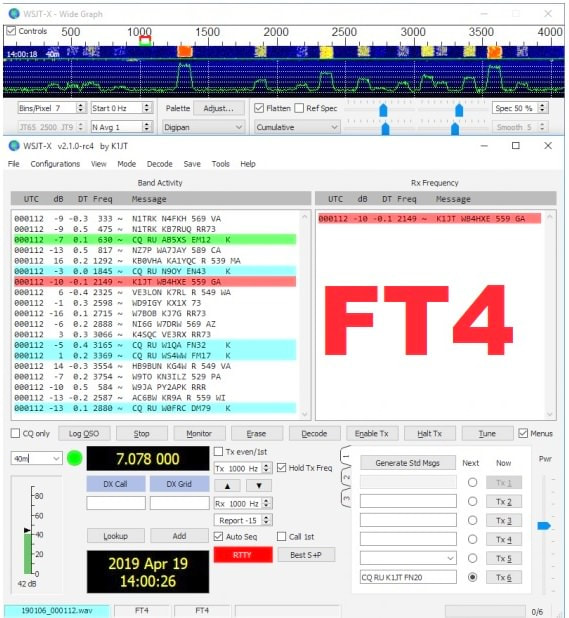The Elmer's Shack
Digital Modes
Where’s The DX?
By Jim Wright, N2GXJ
Oh, it’s there. Quite the geography lesson too! Know where to find Timor-Leste? What about Marquesas Islands? Or Solomon Islands? What about Yemen? How about Trindade & Martim Vaz (what’s that)?
Answer to where to find all of the above : on the airwaves (haha). You can find them on the waterfall display, using FT8, too - if you know where to look. And then to have a best chance of being able to make a contact with them, you’ll need to know what mode of FT8 they are using. For those that are versed in FT8, you’ll already know this. If need a refresher on how to recognize the different FT8 modes, like fox-hound and multi-stream, and how to configure to contact them for each of these modes, see the May 2023 CrossTalk as a refresher. But figuring out the mode assumes you’ve found them. And that is not always easy to do, unless you know some tricks. So how do you find them? How do you find them on the HF radio dial?
Turns out, these “DX Expeditions” are generally not using the standard WSJT-defined FT8 frequencies. So if you just stick to the frequencies plugged into WSJT by default, you are not going to find them. To find them, you can have several options, including checking a spotter network, or running an HF SDR to “see” a larger portion of the band than just where your radio is presently tuned to. Examples of each follow.
For a spotter network example, here is a sample from http://dxsummit.fi/#/ . Here we see a non-standard FT8 frequency (18.107 MHz) listed, vs the usual 18.100, and a comment saying they are using MSHV.
By Jim Wright, N2GXJ
Oh, it’s there. Quite the geography lesson too! Know where to find Timor-Leste? What about Marquesas Islands? Or Solomon Islands? What about Yemen? How about Trindade & Martim Vaz (what’s that)?
Answer to where to find all of the above : on the airwaves (haha). You can find them on the waterfall display, using FT8, too - if you know where to look. And then to have a best chance of being able to make a contact with them, you’ll need to know what mode of FT8 they are using. For those that are versed in FT8, you’ll already know this. If need a refresher on how to recognize the different FT8 modes, like fox-hound and multi-stream, and how to configure to contact them for each of these modes, see the May 2023 CrossTalk as a refresher. But figuring out the mode assumes you’ve found them. And that is not always easy to do, unless you know some tricks. So how do you find them? How do you find them on the HF radio dial?
Turns out, these “DX Expeditions” are generally not using the standard WSJT-defined FT8 frequencies. So if you just stick to the frequencies plugged into WSJT by default, you are not going to find them. To find them, you can have several options, including checking a spotter network, or running an HF SDR to “see” a larger portion of the band than just where your radio is presently tuned to. Examples of each follow.
For a spotter network example, here is a sample from http://dxsummit.fi/#/ . Here we see a non-standard FT8 frequency (18.107 MHz) listed, vs the usual 18.100, and a comment saying they are using MSHV.
If you do have an SDR that can show a wider waterfall than just the 3 kHz or so that you are audio listening to, and if on this display there are any suspicious signals on the band that look like FT8, either above or below the standard FT8 frequency for the band you are on, that is a big clue to tune there to go look.
For an SDR example, here is a view of what I was seeing on a Saturday morning on 12 meters. If I had only tuned to the “standard” 12M FT8 frequency of 24.915 MHz, look at what would have been missing!
For an SDR example, here is a view of what I was seeing on a Saturday morning on 12 meters. If I had only tuned to the “standard” 12M FT8 frequency of 24.915 MHz, look at what would have been missing!
Hope this helps. Good DX everyone!
Fox-Hound or Multi-Stream, How To Reply To That DX?
By Jim Wright, N2GXJ
For those of you who venture off the standard FT-8 frequencies, to where the DXpeditions transmit, you might have been asking this same question that I had been asking, confused by what you are seeing, and not sure of what was right way to respond.
The key was knowing what to look for, which I did not, but do now. Here’s the key.
Look at the signal that is getting decoded when you are running WSJT-X or JTDX. In the waterfall, watch the 2-6 audio frequencies they are simultaneously transmitting on, and then watch the decoded content of these signals. As illustrated in the following real-world on-air examples I captured tonight, in fox/hound mode, you’ll notice the DXpedition (the fox) will sometimes transmit two different messages to two different stations at the same time and on the same audio frequency. That’s something that does not happen in the multi-stream signals of MSHV. That’s your clue to telling these modes apart.
By Jim Wright, N2GXJ
For those of you who venture off the standard FT-8 frequencies, to where the DXpeditions transmit, you might have been asking this same question that I had been asking, confused by what you are seeing, and not sure of what was right way to respond.
The key was knowing what to look for, which I did not, but do now. Here’s the key.
Look at the signal that is getting decoded when you are running WSJT-X or JTDX. In the waterfall, watch the 2-6 audio frequencies they are simultaneously transmitting on, and then watch the decoded content of these signals. As illustrated in the following real-world on-air examples I captured tonight, in fox/hound mode, you’ll notice the DXpedition (the fox) will sometimes transmit two different messages to two different stations at the same time and on the same audio frequency. That’s something that does not happen in the multi-stream signals of MSHV. That’s your clue to telling these modes apart.
DX Using Fox-Hound Example
In the fox-hound example, we can see DX station VU7W in simultaneous QSO with 5 different stations using 3 different audio frequencies. That’s a busy DX station! Lets look at what is being decoded in more detail. On audio frequency 892, he’s giving 73 to NU1O, while giving a signal report to K5AV on that same audio frequency. On audio frequency 1012, he’s giving 73 to NI0G, and a signal report to K4XP on that same audio frequency. There’s also example, on audio frequency 952, where there is only one message to K0UA. That’s fine. That’s why you watch over time, to see if there are any examples of two different stations at the same time on the same audio frequency. That only happens in fox-hound mode. Also, if the DX has properly time sync’d, in fox-hound mode the fox can only transmit on the even periods, so that can be another clue. And in F-H mode, the fox will only answer hounds that are up 1000 Hz or more from where the fox is transmitting. So if you watch who the fox is answering and see where those guys were in audio frequency when they were calling, relative to the fox, that can be another clue too (and a hint as to which audio frequency you should use when trying to get this fox’s attention too!)
In the fox-hound example, we can see DX station VU7W in simultaneous QSO with 5 different stations using 3 different audio frequencies. That’s a busy DX station! Lets look at what is being decoded in more detail. On audio frequency 892, he’s giving 73 to NU1O, while giving a signal report to K5AV on that same audio frequency. On audio frequency 1012, he’s giving 73 to NI0G, and a signal report to K4XP on that same audio frequency. There’s also example, on audio frequency 952, where there is only one message to K0UA. That’s fine. That’s why you watch over time, to see if there are any examples of two different stations at the same time on the same audio frequency. That only happens in fox-hound mode. Also, if the DX has properly time sync’d, in fox-hound mode the fox can only transmit on the even periods, so that can be another clue. And in F-H mode, the fox will only answer hounds that are up 1000 Hz or more from where the fox is transmitting. So if you watch who the fox is answering and see where those guys were in audio frequency when they were calling, relative to the fox, that can be another clue too (and a hint as to which audio frequency you should use when trying to get this fox’s attention too!)
DX Using Multi-Stream Example
In multi-stream example, we see 5 different audio frequencies being used, but only one normal looking FT-8 exchange per audio frequency. And if we watch over time, we’ll never see two different messages transmitted at same time on same audio frequency. That’s our clue that this is multi-stream, and not fox-hound. Unlike in F-H mode, in multi-stream mode, the fox can transmit on either even or odd periods, so if you find a DX transmitting on odd cycles, likely is not in F-H mode (unless their time sync is off).
So how to reply in each of these cases?
If the fox is operating in Fox-Hound mode, you should configure your WSJT-X advanced options to also be in hound mode. Then pay special attention to having the fox low in your waterfall, so that you can pick an audio frequency for your transmit that is at least 1000 Hz higher. Once the fox responds to you, the software will automatically pull your transmit audio frequency down to the audio stream used to give you your signal report. And the QSO concludes simply with them issuing an RR73 (no reply from you expected after that).
If the fox is operating with MSHV in multi-stream mode, you leave your software configured for standard FT-8. Just lock your transmit audio frequency to be somewhere other than where the DX streams are on the waterfall, and operate like standard FT-8.
Hope this helps! Good DX!
In multi-stream example, we see 5 different audio frequencies being used, but only one normal looking FT-8 exchange per audio frequency. And if we watch over time, we’ll never see two different messages transmitted at same time on same audio frequency. That’s our clue that this is multi-stream, and not fox-hound. Unlike in F-H mode, in multi-stream mode, the fox can transmit on either even or odd periods, so if you find a DX transmitting on odd cycles, likely is not in F-H mode (unless their time sync is off).
So how to reply in each of these cases?
If the fox is operating in Fox-Hound mode, you should configure your WSJT-X advanced options to also be in hound mode. Then pay special attention to having the fox low in your waterfall, so that you can pick an audio frequency for your transmit that is at least 1000 Hz higher. Once the fox responds to you, the software will automatically pull your transmit audio frequency down to the audio stream used to give you your signal report. And the QSO concludes simply with them issuing an RR73 (no reply from you expected after that).
If the fox is operating with MSHV in multi-stream mode, you leave your software configured for standard FT-8. Just lock your transmit audio frequency to be somewhere other than where the DX streams are on the waterfall, and operate like standard FT-8.
Hope this helps! Good DX!
Oh To See More!
By Jim Wright, N2GXJ
At one time mysterious, and known to but a few ham radio operators, a waterfall display is now ubiquitous, to the point of comfortable familiarity with most modern hams. For some, it was the venerable FLDIGI that offered them their first foray into “seeing sound”. For those Club-nostalgic historians out there, you might enjoy a time warp flash-back to “seeing sound” from 10 years ago in the March 2012 CrossTalk (http://bit.ly/3TGaROt). For many today, it has been WSJT that has made the introduction, with its scrolling display of multiple FT8 signals all in the same audio passband.
Certainly being able to see the activity for narrow band signals in a 3 kHz audio passband for an FT8 watering hole, like 14.074 MHz, has been great. With such a display of the audio passband, you can tell at a glance where the strong signals are (useful for pouncing), or where the less busy spots on the waterfall might be (for calling CQ).
To get that 3 kHz digitized sample of audio, some radios have a digitization device built-in. For other radios you can use an external device, like a Tigertronics SignaLink USB, for an audio passband to get converted into digits that can then be processed to create a frequency domain waterfall display.
All good, right? Not quite. Turns out that if this is all that you are looking at, you’ll be missing quite a bit of the bigger picture. Like what? Well, for example, you might miss out on making that needed contact with a DXpedition that’s not using the standard FT8 frequency (yes, this is a real thing). You’d never see it on the waterfall if all you were doing is tuning to a standard FT8 frequency, like 14.074 MHz, and looking at the 3 kHz audio bandwidth there.
So, what’s the solution to this? A solution is to simply “see more”. Get a receiving device, or a two-way radio, that can let you see more than just 3 kHz of the HF spectrum at a time.
To illustrate what it means to be able to see more than just 3 kHz of HF spectrum at a time, take a look at the waterfall picture in Figure 1. It is showing 20 kHz of the spectrum, instead of just 3 kHz at a time. What do we see there? Well, let’s take a look.
By Jim Wright, N2GXJ
At one time mysterious, and known to but a few ham radio operators, a waterfall display is now ubiquitous, to the point of comfortable familiarity with most modern hams. For some, it was the venerable FLDIGI that offered them their first foray into “seeing sound”. For those Club-nostalgic historians out there, you might enjoy a time warp flash-back to “seeing sound” from 10 years ago in the March 2012 CrossTalk (http://bit.ly/3TGaROt). For many today, it has been WSJT that has made the introduction, with its scrolling display of multiple FT8 signals all in the same audio passband.
Certainly being able to see the activity for narrow band signals in a 3 kHz audio passband for an FT8 watering hole, like 14.074 MHz, has been great. With such a display of the audio passband, you can tell at a glance where the strong signals are (useful for pouncing), or where the less busy spots on the waterfall might be (for calling CQ).
To get that 3 kHz digitized sample of audio, some radios have a digitization device built-in. For other radios you can use an external device, like a Tigertronics SignaLink USB, for an audio passband to get converted into digits that can then be processed to create a frequency domain waterfall display.
All good, right? Not quite. Turns out that if this is all that you are looking at, you’ll be missing quite a bit of the bigger picture. Like what? Well, for example, you might miss out on making that needed contact with a DXpedition that’s not using the standard FT8 frequency (yes, this is a real thing). You’d never see it on the waterfall if all you were doing is tuning to a standard FT8 frequency, like 14.074 MHz, and looking at the 3 kHz audio bandwidth there.
So, what’s the solution to this? A solution is to simply “see more”. Get a receiving device, or a two-way radio, that can let you see more than just 3 kHz of the HF spectrum at a time.
To illustrate what it means to be able to see more than just 3 kHz of HF spectrum at a time, take a look at the waterfall picture in Figure 1. It is showing 20 kHz of the spectrum, instead of just 3 kHz at a time. What do we see there? Well, let’s take a look.
In this example, we see the “normal” FT8 in the 3 kHz from 14.074 - 14.077 MHz. And because this waterfall is wider in frequency, we also get to see the FT4 activity at the same time happening in the 3 kHz from 14.080 - 14.083 MHz. Nice! But there seems to be even more activity higher in frequency too. And that’s the bonus. Surprise! Turns out, in this example, there’s all kinds of FT8 activity happening up at 14.090 MHz. Without seeing there was activity there, you might never have thought to look there, to get a chance at P29RO (PAPUA NEW GUINEA).
The same trick works when chasing SSB (voice) and other signals too. Turning a tuning dial to try and catch a station calling CQ on USB is luck at best, unless you tune real slow. With a wider bandwidth view, you can see where they are, even if you are not listening where they are transmitting at this moment in time. The wider the bandwidth you can display, the quicker it is to assess where the activity is. This works not just for VHF and UHF, where the bands are very wide, but for HF frequencies as well.
Ever wonder what 20 Meters looks like during a sideband contest? Wonder no longer. Figure 2 is a screen shot during the recent CQ WW SSB contest. This display comes from a wideband SDR capable of digitizing the entire width of the 20 Meter band at one time. Look at all those signals!
The same trick works when chasing SSB (voice) and other signals too. Turning a tuning dial to try and catch a station calling CQ on USB is luck at best, unless you tune real slow. With a wider bandwidth view, you can see where they are, even if you are not listening where they are transmitting at this moment in time. The wider the bandwidth you can display, the quicker it is to assess where the activity is. This works not just for VHF and UHF, where the bands are very wide, but for HF frequencies as well.
Ever wonder what 20 Meters looks like during a sideband contest? Wonder no longer. Figure 2 is a screen shot during the recent CQ WW SSB contest. This display comes from a wideband SDR capable of digitizing the entire width of the 20 Meter band at one time. Look at all those signals!
So let me ask you this. If you were operating remotely, what waterfall bandwidth would you prefer to be able to see? For me, it’s really not a choice at all.
Oh, how great it is to see more! Wouldn’t you agree?
First Ever ARRL International Digital – Add To Your Club’s Score
By Jim Wright, N2GXJ
The first ever. It is the weekend of June 4-5, 2022. Got a few minutes to make FT8 contacts? Want to help see your club, the Gloucester Co ARC, honored in QST magazine? It’s easy! Just make some contacts, and then submit an entry with ‘Gloucester Co ARC’ listed as your club to add your points to a combined club score!
As one of the premiere clubs in the USA, and possibly the world, participating can be fun, and adding your score to the group score is easy. As a group effort, every point helps. Maybe you’ll consider tossing a few points towards your club this way?
Contest begins 1800 UTC Saturday June 4 and runs through 2359 UTC Sunday June 5. You pick which hours you want to operate in that range. Submissions due within a week of contest end. If want help afterwards submitting, just email/call me (n2gxj, in club roster). All the gory details are here : https://contests.arrl.org/ContestRules/Digital-Rules.pdf.
This is a perfect contest tailored to hams like me. They even have a special scoring category overlay for All Enclosed Antennas and limited time (meaning all antennas enclosed within a building, like in my attic, and operated for 8 hours or less). You get one point for each unique callsign per band that you log during the contest. Extra points get added based on how far away the grid square of the station you contacted was from your grid square.
To set up WSJT for this, under settings, on the advanced tab, select special operating activity. Since the ARRL digital contest is new, I don’t see it as a selection option, but the NA VHF Contest can be selected, and gives the right exchange information. Can use that. The contacts will then automatically use your already configured callsign and grid square (“FM29” for those of us in Southern NJ) when making the contest contacts.
Wow. First ever for an annual ARRL contest? That doesn’t happen very often!
Let’s have some digital fun, and toss in some points for the club! Hope to “see” you on the waterfall!
By Jim Wright, N2GXJ
The first ever. It is the weekend of June 4-5, 2022. Got a few minutes to make FT8 contacts? Want to help see your club, the Gloucester Co ARC, honored in QST magazine? It’s easy! Just make some contacts, and then submit an entry with ‘Gloucester Co ARC’ listed as your club to add your points to a combined club score!
As one of the premiere clubs in the USA, and possibly the world, participating can be fun, and adding your score to the group score is easy. As a group effort, every point helps. Maybe you’ll consider tossing a few points towards your club this way?
Contest begins 1800 UTC Saturday June 4 and runs through 2359 UTC Sunday June 5. You pick which hours you want to operate in that range. Submissions due within a week of contest end. If want help afterwards submitting, just email/call me (n2gxj, in club roster). All the gory details are here : https://contests.arrl.org/ContestRules/Digital-Rules.pdf.
This is a perfect contest tailored to hams like me. They even have a special scoring category overlay for All Enclosed Antennas and limited time (meaning all antennas enclosed within a building, like in my attic, and operated for 8 hours or less). You get one point for each unique callsign per band that you log during the contest. Extra points get added based on how far away the grid square of the station you contacted was from your grid square.
To set up WSJT for this, under settings, on the advanced tab, select special operating activity. Since the ARRL digital contest is new, I don’t see it as a selection option, but the NA VHF Contest can be selected, and gives the right exchange information. Can use that. The contacts will then automatically use your already configured callsign and grid square (“FM29” for those of us in Southern NJ) when making the contest contacts.
Wow. First ever for an annual ARRL contest? That doesn’t happen very often!
Let’s have some digital fun, and toss in some points for the club! Hope to “see” you on the waterfall!
|
Here comes FT-4!
By Jim Wright, N2GXJ Hold onto your hats again! The new high octane FT-4 digital mode is scheduled to be unleashed for general availability into the wilds of the amateur radio airwaves all over the world on July 15! This is the latest incarnation in the evolution of digital amateur radio modes from Dr. Joe Taylor’s venerable WSJT-X team. First publically announced in April, FT4 combines RTTY-fast contest contact speeds with an FT-8 like weak signals mode. How fast is it? In its initial incarnation, each transmissions last less than 4.5 seconds! In a QSO, stations alternate |
between sending and receiving every 6 seconds. That’s 2.5 X faster than the 15 seconds between alternate TX and RX with FT-8. In early June, after more feedback from field trials, they’ve extended the time to sending and receiving every 7.5 seconds. Still “dang fast” if you ask me!
How much low signal ability is lost at these speeds? It’s relative. In its initial version, FT4 was claimed to be able to decode successfully down to under -16 dB, which is faintly audible. For those used to using RTTY, that’s far superior (by about 10 dB), and with the added benefit of not taking up as much bandwidth. After more feedback from field trials, they’ve narrowed the bandwidth from 90 Hz to 80 Hz, and added a third decoding pass ability, along with some other improvements, to result an improvement in S/N threshold down to -17.5 dB. For those used to using FT8, where decodes below -20 dB are often possible, it is not as good. But that’s still “dang good” if you ask me!
Deemed “too new” to be allowed to be used for field day this year, the RC version purposefully disabled itself so that it could not be used during this event. But it’s ready now. And so are your favorite tools, like N1MM+, Logbook of the World, and eQSL.cc to receive your logged contacts. The question is, are you ready? We’ll know soon! Starting Monday July 15, check for download availability at : www.physics.princeton.edu/pulsar/k1jt/wsjtx.html.
And stay tuned for other new news from the WSJT team. For the “low banders” out there, there are rumors stemming from an offhanded comment Dr. Joe Taylor, K1JT, made of a new mode in development targeting the new 630/2200 Meter low bands with an S/N limit near -35 dB!
Good DX, and have fun everyone!
How much low signal ability is lost at these speeds? It’s relative. In its initial version, FT4 was claimed to be able to decode successfully down to under -16 dB, which is faintly audible. For those used to using RTTY, that’s far superior (by about 10 dB), and with the added benefit of not taking up as much bandwidth. After more feedback from field trials, they’ve narrowed the bandwidth from 90 Hz to 80 Hz, and added a third decoding pass ability, along with some other improvements, to result an improvement in S/N threshold down to -17.5 dB. For those used to using FT8, where decodes below -20 dB are often possible, it is not as good. But that’s still “dang good” if you ask me!
Deemed “too new” to be allowed to be used for field day this year, the RC version purposefully disabled itself so that it could not be used during this event. But it’s ready now. And so are your favorite tools, like N1MM+, Logbook of the World, and eQSL.cc to receive your logged contacts. The question is, are you ready? We’ll know soon! Starting Monday July 15, check for download availability at : www.physics.princeton.edu/pulsar/k1jt/wsjtx.html.
And stay tuned for other new news from the WSJT team. For the “low banders” out there, there are rumors stemming from an offhanded comment Dr. Joe Taylor, K1JT, made of a new mode in development targeting the new 630/2200 Meter low bands with an S/N limit near -35 dB!
Good DX, and have fun everyone!


